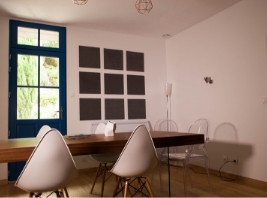Acoustic correction for hi-fi, home cinema and restaurants
Acoustic correction consists in improving the sound environment of a room by limiting its reverberation time. Acoustic treatment products are evaluated by the alpha sabine coefficient. The latter is between 0 and 1. An absorbent material will have a coefficient close to 1, and a non-absorbent material will have a coefficient of 0. This is applied to different frequency ranges in order to give it a technical characterization. Thus, a material can have a coefficient at 0.4 at 200 hz and 0.9 at 1500 hz. In addition, there is the coefficient “W” which characterizes the average acoustic performance of the product. Concretely, precise materials will improve the acoustics of a room. This is what is at stake with acoustic panels, diffusers and bass traps. There are 2 distinct types of acoustic correction objectives:
- Improving speech intelligibility: by making voices more distinct and not needing to “raise their voice” to be heard. This is a recurring problem in environments with an audience or in rooms with high ceilings and/or reverberant materials (bay windows, …).
- To improve the sound reproduction of a music: for listening or recording
Acoustic correction can concern :
- A hi-fi room
- A home cinema
- A house
- A professional and in particular the restaurants
Hi-fi acoustic correction
Acoustic correction can also concern a hi-fi system. You can learn more about this by reading our tutorial on the acoustic treatment of a hi-fi room. However, we will come back here to the difference between active and passive acoustic correction.
Active acoustic correction
The active correction is carried out with an amplifier. Its objective is to control the bandwidth restored in its environment (the room) at first. Then, according to the results, to carry out an equalization of the band in order to obtain a linear response curve: without hollows, nor bumps. Active processing is not a substitute for passive processing. In fact, when you clap your hands, the echo will always be present. The sound reproduction will always be disturbed by the reverberation of the room. Primary reflections will always have a negative impact on the room. The active acoustic treatment is mainly an answer to the bass problems generated by the room. When the response in this frequency band is bad, it allows, with a good placement of the speakers, to avoid the use of bass traps. However, this technology also generates phase rotations and often leads to a loss of transparency. There are 2 types of active correction:
- The analogical one: it is not really topical any more because one speaks especially about band equalizer.
- The digital: it has therefore taken the advantage. It allows, with an embedded computer system, to process more data and to manage them in a more detailed way. Especially with systems such as Lyngdorf or Trinov which are particularly successful.
Passive acoustic correction
The active correction is carried out without an amplifier. It is carried out directly with acoustic treatment products (acoustic panels, diffusers, bass traps). In fact, the passive treatment will be able to modify the physical parameters of a room to free itself from its defects and improve its overall sound. The greatest complexity in the treatment is relative to the low frequencies which requires a heavy treatment. For this reason, active processing can be of great interest in a non-dedicated room.
Home Cinema Acoustic Correction
Acoustic correction is totally inseparable from a home theater. In this context, an acoustic treatment will allow you to immerse yourself fully in your movies. We have written a tutorial on acoustic correction for home cinema. We invite you to have a look at it if you are concerned by it.
Acoustic correction of a room or a house
It may be necessary to make an acoustic correction of his room or a room in his house. This is particularly the case for rooms with reverberant materials or high ceilings. In this case, the objective will be to improve intelligibility in order to regain a certain level of sound and hearing comfort. If you would like to know more, please read our tutorial on the acoustic treatment of a living room.
Acoustic correction of a restaurant room
Acoustic correction is also very important in professional environments. This is particularly the case for restaurants. Indeed, customers are increasingly sensitive to this type of criterion when evaluating and deciding to visit a restaurant. You will better understand the interest of acoustic treatment for restaurants in our dedicated tutorial. You will see how important it is for customers, but also for employees.
The types of acoustic correction: wall and ceiling
Acoustic correction can be carried out with a wall or ceiling treatment.
Acoustic wall correction
This is the most common type of treatment. In small rooms, a wall treatment may suffice. The great interest of a wall panel lies in its personalization and its very advanced decorative aspect.
Acoustic correction ceiling or suspended
A ceiling treatment will mainly concern large volume rooms. A ceiling treatment includes 2 types of panels:
- Ceiling veneered panels: they will be interesting for rooms with low ceiling heights.
- Suspended panels: they will be interesting when the ceiling height is higher.

